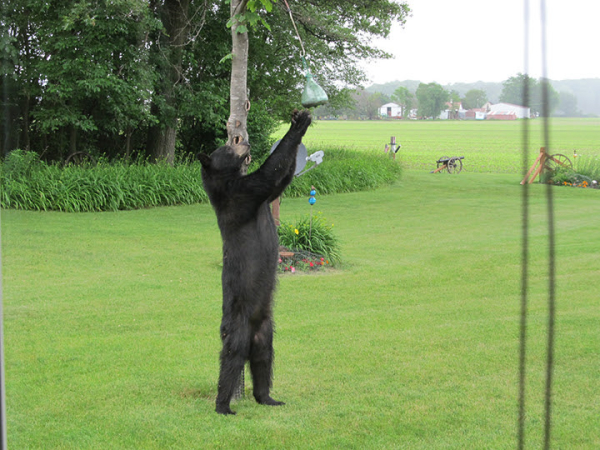
A black bear is looking for an easy snack from a backyard fly trap near Osage, Iowa in 2015. Photo submitted.
|
There’s a pretty good chance that, in the next several weeks, Northeast Iowa will be visited by a few wandering black bears coming down from Minnesota and Wisconsin ahead of the breeding season. It’s been an annual occurrence in this region each spring since 2014.
While much of Iowa does not have the habitat necessary to support a black bear population, certain locations do, primarily northeast, eastern and southern parts of the state. As black bear populations in Wisconsin, Minnesota and Missouri are stable to increasing, it is possible that a small population could set up residence in Iowa.
“Within the next three to five years, I think we can expect to see cubs show up and a small breeding population become established. If that occurs, we should look to our neighbors in Wisconsin and Minnesota who have learned to live with bears,” said Vince Evelsizer, furbearer and wetland wildlife research biologist with the Iowa Department of Natural Resources (DNR). “It won’t be perfect and there will be bumps along the way, but we need to start having conversation about the idea of bears coming back to Iowa, at least in certain places along the Mississippi River and Northeast Iowa where suitable habitat exists.”
Wisconsin’s black bear population is estimated at close to 30,000, Minnesota’s 15,000 and Missouri, which is holding its first bear hunt later this fall, as many as 1,000.
“For example, in Wisconsin, with that many black bears, residents have learned to make a few adjustments to minimize bear conflicts, like putting away their bird seed in the spring, putting away their barbeque drip pans, and by keeping pet food and garbage in places bears can’t access. There are still occasional problems, but these basic precautions result in much fewer negative encounters between bears and humans,” Evelsizer said.
Bears are omnivores and their diet changes with the seasons. In the spring, bears emerge from their winter dens hungry. They’ll feed heavily on newly emerging tender grasses and sedges. In summer, its berries, ants, various plants, and grubs. In the fall, its acorns and other tree nuts. They are also known to feed on nontraditional sources, like row crops, orchard fruits, and honey – which is similar to striped skunks and raccoons.
“They’re like a big raccoon, motivated by hunger and willing to take advantage of whatever food is available, from fawns to eggs, bee hives, bird feeders – this is where making some changes can minimize nuisance bear interactions,” he said.
Black bears are native to Iowa. However, Iowa has been without a resident bear population for more than 100 years. In the Iowa code, black bears are not listed as a species of wildlife found in Iowa because they were not present in the state when these laws were created, nor have they been since. This means the Iowa DNR does not have the legal authority to manage black bear populations through actions such as designating protection status or adding a limited hunting season if the population eventually support it in the future. Iowa is the only state among its Midwest neighbors where the state’s wildlife agency does not have regulatory authority to manage bear populations, which typically includes handling nuisance conflicts and conducting research.
While the Iowa DNR does not regulate bears, it does have a bear response protocol.
“The objective with the response protocol is to provide guidance for our staff in dealing with any potential human-bear conflicts that arise. A proactive strategy will increase the odds for a better outcome for both the bears and for humans. For example, trap and transport of bears is a common scenario shown on TV shows, however in reality most states have moved away from this method because it often results in simply moving the problem to someone else’s backyard. It’s all about reducing conflicts where bears are instead,” Evelsizer said. “We want to keep Iowans informed about this interesting and emerging wildlife story and increase our collective knowledge about bears in order to live with them successfully and minimize conflicts.”
Since 2002, there have been 43 confirmed black bears in Iowa, and two to five per year since 2014. As bears have become more of a regular visitor, the chance to encounter a bear, although small, is a possibility.
“Black bears have some general tendencies and habits, but individual bears may go against the norm. Some are shy, others are not. They are typically secretive and want to be left alone – while others are bold and may be more daylight active,” he said.
Bears are typically nocturnal but get more active during the June to July breeding season, especially at dawn and dusk. Most of Iowa’s bear sightings start in late May continuing into July.
“If you encounter a bear, avoid running away,” Evelsizer said. “Instead, back away slowly and cautiously while facing it. Make noise so they know you’re there.”
There are a number of resources available to help people minimize conflict with bears, Evelsizer said, including www.bearwise.org
Media Contact: Vince Evelsizer, Furbearer and Wetland Wildlife Research Biologist, Iowa Department of Natural Resources, 641-231-1522.